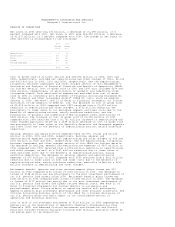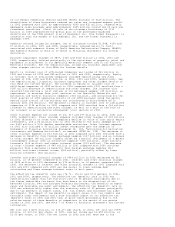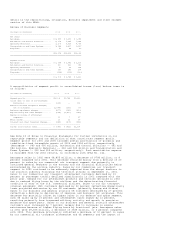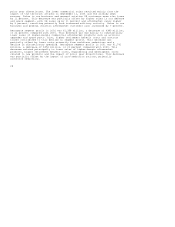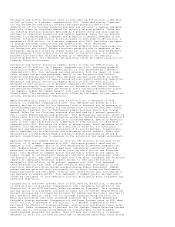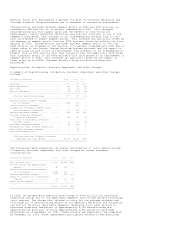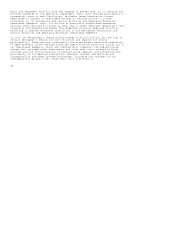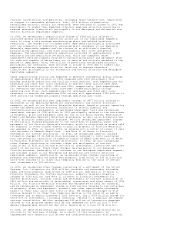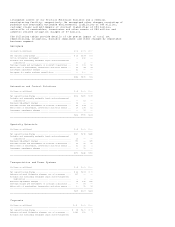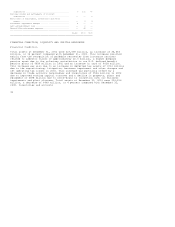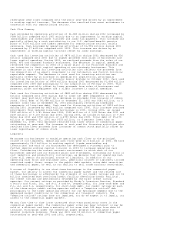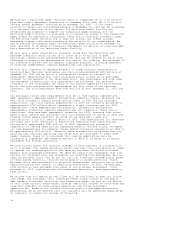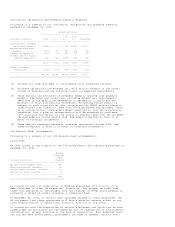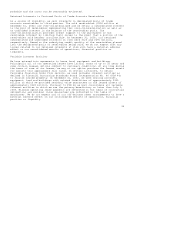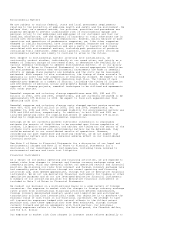Honeywell 2002 Annual Report Download - page 215
Download and view the complete annual report
Please find page 215 of the 2002 Honeywell annual report below. You can navigate through the pages in the report by either clicking on the pages listed below, or by using the keyword search tool below to find specific information within the annual report.contract cancellations and penalties, including lease terminations, negotiated
or subject to reasonable estimation. Also, $119 million of previously
established accruals, mainly for severance, were returned to income in 2001 due
principally to higher than expected voluntary employee attrition resulting in
reduced severance liabilities, principally in our Aerospace and Automation and
Control Solutions reportable segments.
In 2000, we recognized a repositioning charge of $338 million related to
announced global workforce reductions across all of our reportable segments,
costs to close a chip package manufacturing plant and related workforce
reductions. The charge also included asset impairments principally associated
with the completion of previously announced plant shutdowns in our Specialty
Materials reportable segment and the closure of an affiliate's chemical
manufacturing operations, and other environmental exit costs and period
expenses. The announced workforce reductions consisted of approximately 2,800
manufacturing and administrative positions, which are complete. Asset
impairments were principally related to manufacturing plant and equipment held
for sale and capable of being taken out of service and actively marketed in the
period of impairment. Also, $46 million of previously established accruals,
principally for severance, were returned to income in 2000 due to higher than
expected voluntary employee attrition resulting in reduced severance
liabilities, principally in our Automation and Control Solutions and Aerospace
reportable segments.
These repositioning actions are expected to generate incremental pretax savings
of approximately $400 million in 2003 compared with 2002 principally from
planned workforce reductions and facility consolidations. Cash expenditures for
severance and other exit costs necessary to execute these actions were $447,
$422 and $344 million in 2002, 2001 and 2000, respectively. Such expenditures
for severance and other exit costs have been funded principally through
operating cash flows. Cash expenditures for severance and other exit costs
necessary to execute the remaining 2002 actions will approximate $350 million in
2003 and will be funded principally through operating cash flows.
In 2002, we recognized business impairment charges of $877 million related to
businesses in our Specialty Materials and Automation and Control Solutions
segments, as well as our Friction Materials business. Based on current operating
losses and deteriorating economic conditions in certain chemical and
telecommunications end-markets, we performed impairment tests and recognized
impairment charges of $785 million in 2002 principally related to the write-down
of property, plant and equipment held for use in our Nylon System, Performance
Fibers and Metglas Specialty Materials businesses, as well as an Automation and
Control Solutions communication business. We also recognized impairment charges
of $92 million related principally to the write-down of property, plant and
equipment of our Friction Materials business, which is classified as assets held
for disposal in Other Current Assets (a plan of disposal of Friction Materials
was adopted in 2001; in January 2003, we entered into a letter of intent to sell
this business to Federal-Mogul Corp. --see Note 21 of Notes to Financial
Statements for further discussion). In 2002, we recognized asbestos related
litigation charges of $1,548 million principally related to costs associated
with the potential resolution of asbestos claims of NARCO (see Note 21 of Notes
to Financial Statements for further discussion). In 2002, we also recognized
other charges consisting of customer claims and settlements of contract
liabilities of $152 million and write-offs of receivables, inventories and other
assets of $60 million. These other charges related mainly to our Advanced
Circuits business, bankruptcy of a customer in our Aerospace reportable segment,
and customer claims in our Aerospace and Automation and Control Solutions
reportable segments. Additionally, we recognized other charges consisting of
probable and reasonably estimable environmental liabilities of $30 million and
write-offs related to an other than temporary decline in the value of certain
cost investments of $15 million.
In 2001, we recognized other charges consisting of a settlement of the Litton
Systems, Inc. litigation for $440 million, probable and reasonably estimable
legal and environmental liabilities of $249 million (see Note 21 of Notes to
Financial Statements for further discussion), asbestos related litigation
charges of $159 million (see Note 21 of Notes to Financial Statements for
further discussion), customer claims and settlements of contract liabilities of
$310 million and write-offs of receivables, inventories and other assets of $335
million. Our Friction Materials business was designated as held for disposal,
and we recognized an impairment charge of $145 million related to the write-down
of property, plant and equipment, goodwill and other identifiable intangible
assets to their fair value less costs to sell. We recognized charges of $112
million related to an other than temporary decline in the value of an equity
investment and an equity investee's loss contract, and a $100 million charge for
write-off of investments, including inventory, related to a regional jet engine
contract cancellation. We also recognized $42 million of transaction expenses
related to the proposed merger with GE and redeemed our $200 million 5 3/4%
dealer remarketable securities due 2011, resulting in a loss of $6 million.
In 2000, we identified certain business units and manufacturing facilities as
non-core to our business strategy. As a result of this assessment, we
implemented cost reduction initiatives and conducted discussions with potential


